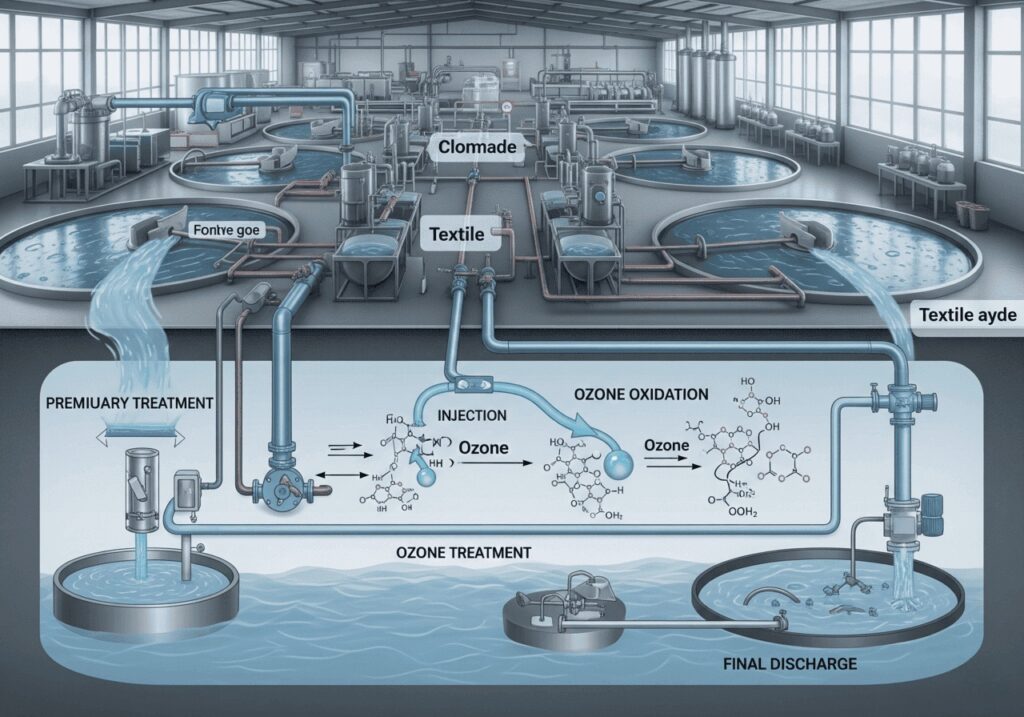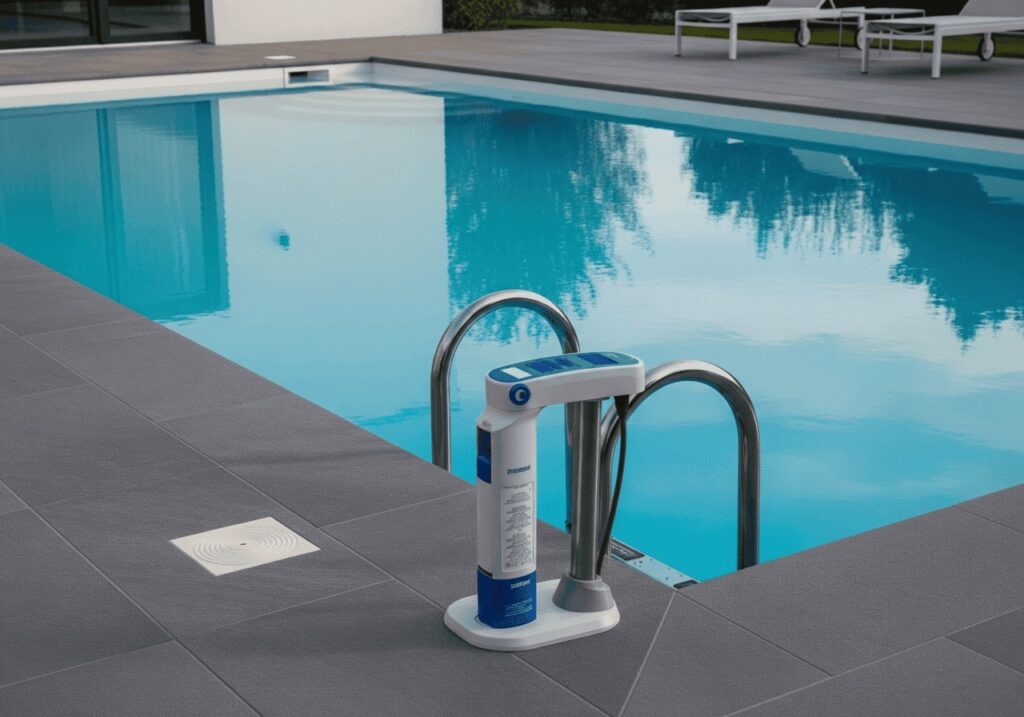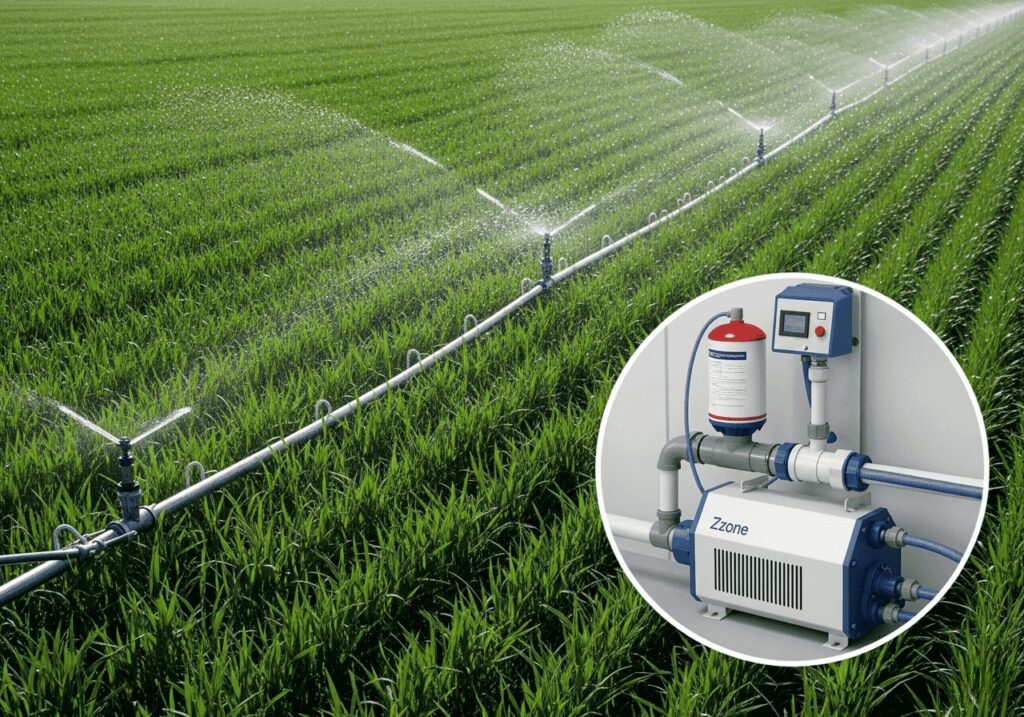Ozone (O₃) is a powerful and efficient tool for water treatment that is increasingly used across various industries. Known for its chemical-free disinfection abilities, ozone provides an eco-friendly solution that removes harmful contaminants without leaving toxic residues. In this article, we will explore real-world case studies of how ozone for water treatment is being successfully applied across industries like textiles, agriculture, municipal water, and more.

Ozone for Textile Industry Wastewater Treatment
A textile factory in China was struggling with its wastewater, which contained high levels of dyes and chemicals. Traditional chemical treatments were both expensive and inefficient at removing these contaminants.
The Problem:
The factory’s wastewater contained harmful dyes and chemicals that made it difficult to meet local environmental regulations. The factory needed a more efficient and cost-effective way to treat the water.
The Solution:
The factory decided to install an ozone-based water treatment system. Ozone, a strong oxidizer, breaks down pollutants like dyes and chemicals into simpler, non-toxic substances.
The Results:
- A 90% reduction in chemical oxygen demand (COD), improving water quality.
- Compliance with local environmental regulations, avoiding fines.
- Reduced chemical use, cutting operational costs.
This case shows that ozone for wastewater treatment can effectively address complex pollution, reduce chemical dependency, and ensure regulatory compliance.
Case Study 2: Municipal Water Treatment Using Ozone
A European city was facing challenges with chlorine-based water treatment. The use of chlorine left behind a strong, unpleasant taste and odor, which was becoming a growing concern for residents.
The Problem:
While chlorine effectively disinfected the water, it left an unwanted taste and odor. This was causing dissatisfaction among residents, and the city needed a solution that would improve the water quality.
The Solution:
The city switched to an ozone water treatment system, which not only disinfects water but also eliminates bad taste and odors by breaking down the organic compounds that cause them.
The Results:
- Improved water quality, with no chlorine taste or odor.
- Enhanced disinfection, reducing pathogens more effectively than chlorine.
- Lower operational costs due to reduced chemical use.
This case illustrates how ozone for municipal water treatment can improve both the safety and aesthetic quality of drinking water.

Case Study 3: Swimming Pool Water Treatment with Ozone
A luxury resort in the Maldives was dealing with chlorine’s adverse effects on guests. Skin irritation and eye discomfort were common complaints, prompting the resort to find a more guest-friendly solution.
The Problem:
Chlorine disinfection caused irritation, affecting the guest experience. The resort needed a solution that would improve water quality without harsh chemicals.
The Solution:
The resort implemented an ozone-based water treatment system. Ozone disinfects the water effectively, eliminating the need for chlorine and minimizing its harmful effects on skin and eyes.
结果:
- 客人报告皮肤和眼睛刺激减少。
- The pool water remained crystal clear and free of chemical byproducts.
- The resort lowered its environmental footprint by reducing chlorine usage.
This case highlights how ozone for swimming pools can improve the guest experience while reducing the need for chemicals.

案例研究4:臭氧在农业和灌溉中的应用
加州一家农场面临水传播疾病侵袭作物的问题。该农场需要一种环保的解决方案,既能保护作物,又不依赖有害化学物质。
The Problem:
Waterborne pathogens were a major issue in the farm’s irrigation systems. Traditional chemical treatments were not ideal for organic farming, and the farm sought a more natural solution.
The Solution:
The farm switched to ozone-treated irrigation water. Ozone efficiently kills harmful pathogens, improving water quality and promoting healthier crops.
The Results:
- Improved crop health and increased yield.
- Reduced need for chemical pesticides, making farming more sustainable.
- Healthier soil with fewer chemical residues, supporting organic farming practices.
This case shows that ozone for irrigation can help farmers improve crop health and reduce pesticide use, supporting sustainable agriculture.

Case Study 5: Ozone in Aquaculture for Water Purification
An aquaculture facility in Vietnam needed to maintain high water quality for its fish farming operations. The facility was facing disease outbreaks due to poor water conditions and sought a solution that would minimize the use of antibiotics.
The Problem:
The facility struggled with frequent disease outbreaks, and the use of antibiotics was high, which raised production costs and affected fish quality.
The Solution:
The facility introduced an ozone-based water treatment system to disinfect the water and prevent disease outbreaks without relying on antibiotics. Ozone is highly effective at eliminating bacteria and viruses in the water.
The Results:
- Reduced antibiotic usage, improving fish quality and lowering costs.
- Enhanced water quality, leading to healthier fish.
- Reduced environmental impact due to lower chemical usage.
This case demonstrates that ozone for aquaculture can improve water quality, reduce antibiotic dependence, and make operations more sustainable.
Case Study 6: Pharmaceutical Water Treatment with Ozone
A pharmaceutical manufacturing plant in the United States needed to meet high purity and microbial quality standards for its water. The water used in production had to be free from contaminants that could affect product quality.
The Problem:
The plant needed a more effective water treatment method to ensure that the water met stringent pharmaceutical-grade quality standards.
The Solution:
The plant implemented an ozone water treatment system that effectively removes both organic and inorganic contaminants. Ozone helps ensure the water is pure and free of harmful microorganisms.
The Results:
- The water met the required pharmaceutical-grade standards, ensuring product safety.
- No harmful residues were left in the water, as ozone decomposes into oxygen.
- The plant maintained compliance with strict regulatory standards for water quality.
This case highlights the importance of ozone in pharmaceutical water treatment, ensuring water purity and compliance with health and safety regulations.
Conclusion: The Benefits of Using Ozone for Water Treatment
Ozone is a versatile and effective solution for water treatment, offering numerous benefits across various industries. Its powerful oxidizing ability allows it to remove a wide range of contaminants, from bacteria and viruses to organic compounds and metals. Unlike traditional methods, ozone decomposes into oxygen, leaving no harmful residues and making it an eco-friendly option.
The key benefits of ozone for water treatment include:
- Effective disinfection: Ozone kills a broad range of pathogens, ensuring safe water.
- Eco-friendly: Ozone breaks down into oxygen, leaving no toxic byproducts.
- Cost savings: By reducing chemical usage, ozone lowers operational costs.
- Quick action: Ozone reacts rapidly with contaminants, providing efficient treatment.
Whether you’re looking to improve industrial wastewater quality, enhance drinking water safety, or ensure healthier agricultural practices, ozone offers a sustainable and effective solution for water purification.
部分资料参考来源:https://www.epa.gov/water-research/treatment-and-control-drinking-water-contaminants-research,https://news.uark.edu/articles/68018/study-shows-limits-of-ozonated-water-as-sanitizer-in-raw-veggie-processing,
read more
Read More:
For more information on ozone water treatment and its benefits, consider checking out these valuable sources:
- EPA on Ozone Disinfection for Drinking Water
- Study Shows Limits of Ozonated Water as Sanitizer in Raw Veggie Processing
These resources provide additional insights into the use of ozone for water treatment, its effectiveness, and emerging applications in various industries.